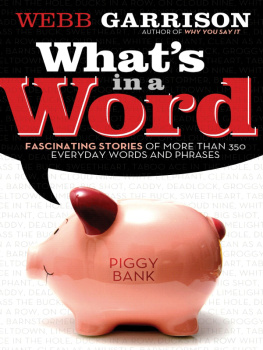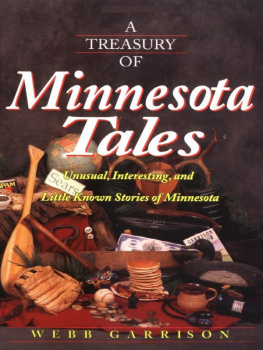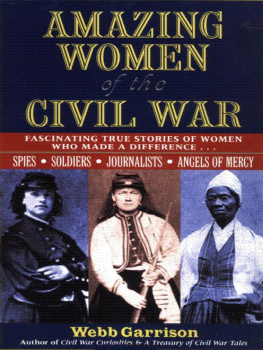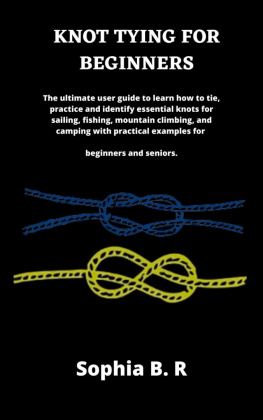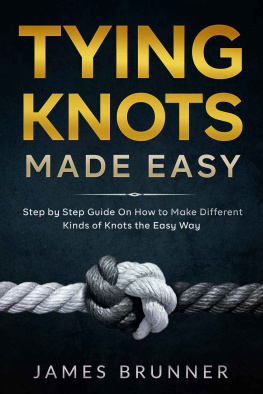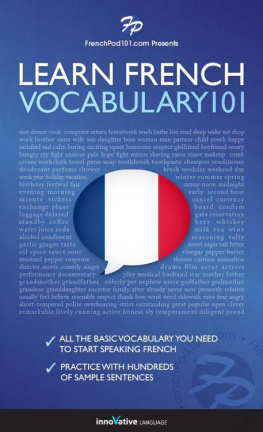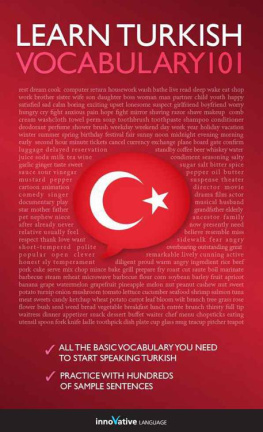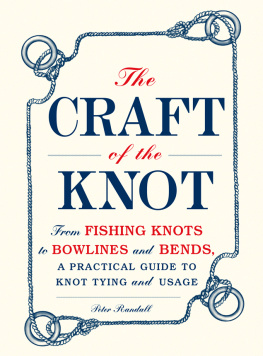
W HATS
IN A
W ORD?
W HATS
IN A
W ORD?
Webb Garrison
RUTLEDGE HILL PRESS
Nashville, Tennessee
A Division of Thomas Nelson, Inc.
www.ThomasNelson.com
Copyright 2000 by Webb Garrison
All rights reserved. Written permission must be secured from the publisher to use or reproduce any part of this book, except for brief quotations in critical reviews and articles.
Published by Rutledge Hill Press, a division of Thomas Nelson, Inc., P.O. Box 141000, Nashville, Tennessee 37214.
Illustrations by Jason Shulman
Design by Harriette Bateman
Library of Congress Cataloging-in-Publication Data
Garrison, Webb B.
Whats in a word? / Webb Garrison.
p. cm.
Includes bibliographical references and index.
ISBN 10: 1-55853-811-9
ISBN 13: 978-1-55853-811-5
1. English languageEtymology. I. Title.
PE1574 .G29 2000
422dc21
00-035288
CIP
Printed in the United States of America
06 07 08 09 10 21 20 19 18 17
CONTENTS
SHORT SHORT STORIES
C OBWEBS sometimes appear overnight, even in the best-kept quarters. These nuisances are such a common occurrence their name may seem prosaic. However, that is far from the case. In chapter 10 you will discover that a long-abandoned name for the spider is seen to have played a major role in the development of the word that now seems so ordinary.
Practically every word and phrase that we use is an easy-to-swallow verbal capsule. Theyre often potent and complex, being the end result of centuries of use. I have been fascinated by etymology (the study of word origins and developments) since my youth. I wrote brief word studies for the Ladies Home Journal, which published three or four of them every month for years. One of the Journals readers, who lived in what was then the Transvaal Africa, wrote to the editors of the magazine suggesting they publish the word studies together in a book. This led to a 1955 volume made up of reprinted material from Ladies Home Journal, Catholic Digest, Mechanix Illustrated, Better Homes and Gardens, Golf Digest, Elementary Electronics, and other publications.
Like the previous book, this book is written in the form of short short storiesabbreviated forms of the American short story in which O. Henry excelled. The vignettes included here are brief enough for bathroom reading, and many of them include surprise endings almost, but not quite, in the fashion of Paul Harveys tales.
The words and phrases in this book are divided into chapters on a somewhat arbitrary basis. Since it is intended for fun reading, the categories are mainly a way to segment the book. The index will help with reference use.
The words and phrases in this book were selected on the basis of interest, not because one is more significant and useful than another. Scholars who devote their whole lives to etymology have thick volumes dealing with words and phrases that are so complex its difficult to follow their trails. Though they are an important aspect of our language, words and phrases of this sort are not included here. Everything here was selected for third millennial use. There are very new and very old words and phrases. Heres wishing you lots of fun, plus maybe a bit of learning!
Webb Garrison
Lake Junaluska, North Carolina
in the heart of the Great Smokies
CHAPTER 1
HIGH TECHNOLOGY
AND THE
COMPUTER AGE
HIT
THE TUBE / BOOB TUBE
COMPUTER
CURSOR
MOUSE
VIRUS
ROBOT
THE DOW
CHIP
E-MAIL
FLOPPIES
GIG
HACKER
TO BOOT
FERRET
SPAM
CD-ROM
BULLET
ANTENNA
BYTE
BROWSER
BOOKMARK
BIT
Hit
S OMEONE who connects with a target scores a hit. In baseball, players have distinguished between a hit in which the ball is fair, within bounds, or a foul ball, one that is out of bounds. A successful Broadway play, motion picture, television series, book, syndicated column, or comic strip characteralong with many other thingsis also dubbed a hit.
This ancient word soon came to designate a computer users visit to a Web site. Since each such visit can be counted by means of a relatively simple program, the popularityand hence the importanceof a Web site is measured in terms of how often a hit is registered in the course of a day, a week, or a month.
The Tube / Boob Tube
B EFORE the advent of flat screens and high definition television, all TVs functioned by means of a cathode ray tube. This factor, plus the shapes of early sets, fostered the use of the term the tube to designate a television set of any kind or size. Derogatory remarks about the quality of material seen on the tube prompted many Americans to begin sneering at the television, calling it the boob tube. Although digital television is sure to take over in the third millennium, such a tubeless set is likely to continue to be called the tube.
Computer
H UMANS were the earliest computers. These counting persons were professionals who worked with numbers and were credited with great accuracy. There is a nursery rhyme that talks about a king counting his money in his counting house. He was at the financial center of his kingdom where he almost certainly had computers doing the work. This early computing was manual and involved the use of such counting tools as the abacus and a variety of slide rules. When adding machines were developed, the man or woman who computed with one of these then-rapid devices often called the counting machine a computer. Used in this fashion, the hoary old term took on new life when it became attached to electronic data processing and storage devices.
Cursor
A LATIN term for flowing or running gave rise to the word cursive to describe handwriting produced in flowing style. The flow of letters that is produced when a pen is guided by skilled fingers is an impressive art. The name for this efficient and effortless writing style, in this computer age, soon was adapted and bestowed upon the small marker that moves quickly and gracefully across a computer screen. The cursor blinks until stimulated into action.
Mouse
A WEE rodent, usually brownish or grayish brown in color, abounds throughout the world. Its English name is derived from the same classical term that named the modern musclealso small and often fast-moving. No known culture or civilization, ancient or modern, is known to have been without this creature.
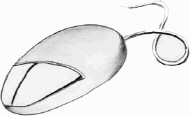
Late last century engineers developed a little hand-held device used to control movements of a cursor. This device is small and rounded and has a cord that looks like a tail; hence, they called it a mouse. Although the shapes have changed some over the years, the catchy name is likely to remain.
Virus
W HEN scientists first isolated a minute parasitic structure that causes serious illness, they called it a virus, which is Latin for poison. Unable to live in isolation, a virus can reproduce with incredible speed when inside a suitable host organism such as a human body. When hackers and other computer enthusiasts who found out how to insert a small self-replicating program into a larger host program, the name was obvious: electronic virus. Such a set of data cannot travel or survive by itself but thrives as a parasite when it gets inside a computer. Like a submicroscopic particle of biochemistry, a computer virus can do great damage to any host in which it lodges, whether sent there deliberately or picked up accidentally.
Next page
